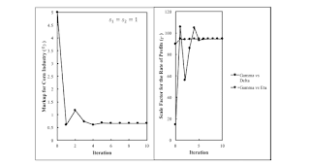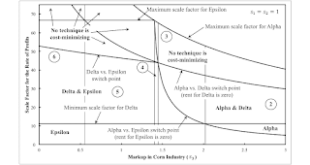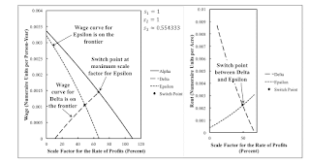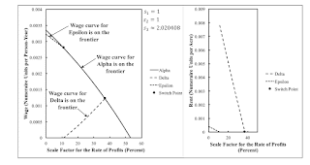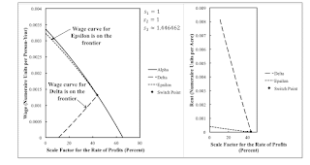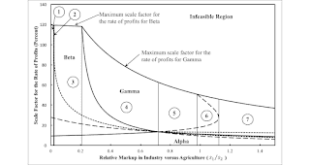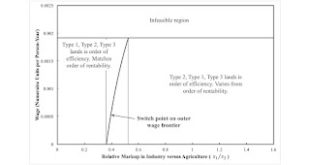[embedded content]Hakim on the Economic Calculation Problem Reactionaries often bring up the Economic Calculation Problem (ECP) as a fatal objection to socialism, considered as entailing central planning. Ludwig Von Mises put this forth in 1920 as an argument in principle that central planning is guaranteed to be highly inefficient. He postulates that the planning authority knows the prices of consumer goods and all technical possibilities, including the endowments of originary factors of...
Read More »How To Find Fluke Switch Points
Figure 1: Convergence of Newton Method This post steps through an algorithm for finding a fluke switch point. I used a different example when I tried to explain this before. Today, I use an example building on my draft ROPE Article. Consider Figure 3 in this post, repeated below as Figure 2. Let s1 = s2 = 1. I want to find s3, the markup in the corn industry, such that the wage curves for Gamma, Delta, Eta, and Theta intersect at a single switch point. One wants to find a function one of...
Read More »Variation With Markups Of The Analysis Of The Choice Of Technique With Intensive Rent
Figure 1: Variation of the Technique with Markup in Agriculture This post is a continuation a of a previous example. I suppose this is the first example in post Sraffian price theory which combines intensive rent and markup pricing. I do not plan on trying to publish it, in a stand-alone article. D'Agata (1983) sets some coefficients to zero to simplify it for his purposes. I would like a range of parameters where I get reswitching or capital-reversing. I have found a case where, given the...
Read More »An Alpha Vs. Delta Pattern For The r-Order Of Fertility With Intensive Rent And Markup Pricing
Figure 1: Wage Curves and Rent for an Example of Intensive Rent This post is a continuation of a previous example. This is a fluke case insofar as the Alpha and Delta wage curves intersect at the scale factor for the rate of profits that is the maximum possible for the Epsilon technique. This fluke case is associated with a qualitative change in the range of the scale factor for the rate of profits in which no cost-minimizing technique exists. The technology, endowments, requirements...
Read More »A Pattern For The r-Order Of Fertility With Intensive Rent And Markup Pricing
Figure 1: Wage Curves and Rent for an Example of Intensive Rent The first man who, having enclosed a piece of ground, bethought himself of saying, 'This is mine', and found people simple enough to believe him, was the real founder of civil society. From how many crimes, wars and murders, from how many horrors and misfortunes, might not anyone have saved mankind by pulling up the stakes, filling in the ditch, and crying to his fellows, 'Beware of listening to this imposter; you are undone if...
Read More »A Three-Technique Pattern With Intensive Rent And Markup Pricing
Figure 1: Wage Curves and Rent for an Example of Intensive Rent1.0 Introduction This post is one in a series exploring variations of an example from Antonio D'Agata (1983). This post demonstrates that at least one of my fluke cases can appear in a model of intensive rent by varying a parameter specifying relative markups among sectors. This post is only a start of exploring the parameter space of relative markups in a specific numeric example of intensive rent. Suppose the rate of...
Read More »Extensive Rent, Absolute Rent, and Markup Pricing
Figure 1: Variation of Technique with Relative Markups1.0 Introduction This is a rewrite of a previous post with somewhat 'nicer' values for coefficients of production. I also expand on it with some observations on absolute rent. As far as I know, these posts are the first explicit presentation in the post-Sraffian tradition of a model of the prices of production with extensive rent and markup pricing. These posts explore the conflict over distribution among workers, capitalists, and...
Read More »Extensive Rent and Markup Pricing In A Complicated Example
Figure 1: Variation of Technique with Relative Markups "That 'diminishing returns' was not an essential element in the surplus-based theory emerged in Marx's criticisms of Ricardo. Sraffa (1960), in his short chapter on land, the implications of which have yet to be developed, shows how the classical view of rents need not necessarily rest on the conception of 'the law of diminishing returns' or need not suggest necessarily any functional relationship between output and cost, or even presume...
Read More »Competitive Capitalism Rewards Inefficiency: The Production of Commodities with Extensive Rent and Markup Pricing
Figure 1: Order of Rentability Varying with Relative Markups1.0 Introduction Ownership is not productive, as Joan Robinson informs us. But, at least under competitive conditions one might hope, more productive assets earn their owners more than less productive assets. And this applies to scarce skills as well. But none of this is necessarily true, either. This article presents a numerical example in which, among scarce lands, rent per acre is higher on more fertile land only when...
Read More »Elsewhere
Isabella Weber's Sellers' inflation, profits and conflict: why can large firms hike prices in an emergency?, in the Review of Keynesian Economics. Isabella Weber et al Inflation in times of overlapping emergencies: systemically significant prices from an input-output perspective, a working paper. Zachary Carter's profile of Isabella Weber in the New Yorker. Noah Smith's muddle and more muddle. Zachary Carter has a book, The Price of Peace: Money, Democracy, and the Life of John...
Read More » Heterodox
Heterodox

